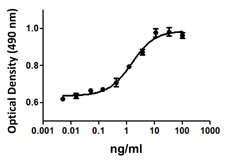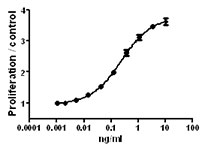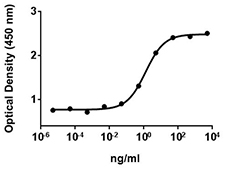- Regulatory Status
- RUO
- Other Names
- Bone morphogenetic protein 4, BMP-2B, DVR4
- Ave. Rating
- Submit a Review
- Product Citations
- publications
| Cat # | Size | Price | Quantity Check Availability | Save | ||
|---|---|---|---|---|---|---|
| 595201 | 2 µg | £65 | ||||
| 595202 | 10 µg | £150 | ||||
Bone morphogenetic proteins (BMPs) are multi-functional growth factors that belong to the transforming growth factor beta (TGFbeta) superfamily. BMPs play a key role in embryonic development, especially during heart, neural and cartilage development. Around 20 BMP family members have been identified and characterized. BMPs signal through serine/threonine kinase receptors, composed of type I and II subtypes. Four type I receptors have been identified: type IA and IB BMP receptors, type IA activin receptor, and activin receptor-like kinase I. Three type II receptors have also been recognized: type II BMP receptor and type II / IIB activin receptors. BMP-4 gene is conserved in human, chimpanzee, Rhesus monkey, dog, cow, mouse, rat, and zebrafish. BMP-2 and BMP-4 are highly similar; they have 92% amino acid sequence identity. BMP-4 is required for mesoderm formation and patterning in mice, and BMP-4 KO mice are embryonic-lethal. BMP-4 has an important role in postnatal tooth cytodifferentiation. Overexpression BMP-4 has been associated with fibrodysplasia ossificans progressiva (FOP). Overexpression of BMP-4 has also been associated with cancer, including melanoma, hepatocellular carcinoma, adenocarcinoma and colorectal cancer cell lines. This overexpression can promote migratory and invasive properties of cancer cells.
Product DetailsProduct Details
- Source
- Human BMP-4, amino acids (Lys303 -Arg408) (Accession# NM_001202), was expressed in E. coli.
- Molecular Mass
- The 106 amino acid recombinant protein has a predicted molecular mass of approximately 12 kD. The DTT-non reduced protein migrates at approximately 31-36 kD on SDS-PAGE. The predicted N-terminal amino acid is Lys.
- Purity
- >97%, as determined by Coomassie stained SDS-PAGE and HPLC analysis.
- Formulation
- Lyophilized
- Endotoxin Level
- Less than 0.1 ng per µg of protein.
- Storage & Handling
- Unopened vial can be stored at -20°C or -70°C. For maximum results, quick spin vial prior to opening. Reconstitute 5 mM HCl, pH 3.0 to a concentration of 0.1-1.0 mg/ml. Do not vortex. It is recommended to further dilute in a buffer containing a carrier protein such as 0.1% BSA and store working aliquots at -20°C to -80°C. Avoid repeated freeze/thaw cycles.
- Activity
- BMP-4 induces alkaline phosphatase production on ATDC-5 cells. The expected ED50 for this effect is 5-10 ng/ml, corresponding to 1-2 x 105 unit/mg.
- Application
-
Bioassay
Antigen Details
- Structure
- Growth factor, homodimer
- Distribution
- Osteoblast, odontoblast, ameloblasts, megakaryocytes, endothelial cells. Lymphoblastoid cell lines from patients with fibrodysplasia ossificans progressiva.
- Function
- BMP-4 induces endochondral osteogenesis, fracture healing, and tooth development.
- Interaction
- Condroblast, osteoblast, retinoblastoma cells.
- Ligand/Receptor
- Type I receptors BMPR-IA (ALK-3) and BMPR-IB (ALK-6).
- Cell Type
- Neural Stem Cells, Mesenchymal Stem Cells, Hematopoietic stem and progenitors, Embryonic Stem Cells
- Biology Area
- Angiogenesis, Cell Biology, Neuroscience, Stem Cells, Synaptic Biology
- Molecular Family
- Growth Factors, Cytokines/Chemokines
- Antigen References
-
1. ten Dijke, et al. 1994. J. Biol. Chem. 269:16985.
2. Shafritz AB, et al. 1996. New Eng. J. Med. 335:555.
3. Chen D, et al. 2004. Growth Factors 22:233.
4. Gluhak-Heinrich J, et al. 2010. Bone 46:1533.
5. Haubold M, et al. 2010. Int. J. Biol. Sci. 6:700. - Gene ID
- 652 View all products for this Gene ID
- UniProt
- View information about BMP-4 on UniProt.org
Related FAQs
- Why choose BioLegend recombinant proteins?
-
• Each lot of product is quality-tested for bioactivity as indicated on the data sheet.
• Greater than 95% Purity or higher, tested on every lot of product.
• 100% Satisfaction Guarantee for quality performance, stability, and consistency.
• Ready-to-use liquid format saves time and reduces challenges associated with reconstitution.
• Bulk and customization available. Contact us.
• Learn more about our Recombinant Proteins. - How does the activity of your recombinant proteins compare to competitors?
-
We quality control each and every lot of recombinant protein. Not only do we check its bioactivity, but we also compare it against other commercially available recombinant proteins. We make sure each recombinant protein’s activity is at least as good as or better than the competition’s. In order to provide you with the best possible product, we ensure that our testing process is rigorous and thorough. If you’re curious and eager to make the switch to BioLegend recombinants, contact your sales representative today!
- What is the specific activity or ED50 of my recombinant protein?
-
The specific activity range of the protein is indicated on the product datasheets. Because the exact activity values on a per unit basis can largely fluctuate depending on a number of factors, including the nature of the assay, cell density, age of cells/passage number, culture media used, and end user technique, the specific activity is best defined as a range and we guarantee the specific activity of all our lots will be within the range indicated on the datasheet. Please note this only applies to recombinants labeled for use in bioassays. ELISA standard recombinant proteins are not recommended for bioassay usage as they are not tested for these applications.
- Have your recombinants been tested for stability?
-
Our testing shows that the recombinant proteins are able to withstand room temperature for a week without losing activity. In addition the recombinant proteins were also found to withstand four cycles of freeze and thaw without losing activity.
- Does specific activity of a recombinant protein vary between lots?
-
Specific activity will vary for each lot and for the type of experiment that is done to validate it, but all passed lots will have activity within the established ED50 range for the product and we guarantee that our products will have lot-to-lot consistency. Please conduct an experiment-specific validation to find the optimal ED50 for your system.
- How do you convert activity as an ED50 in ng/ml to a specific activity in Units/mg?
-
Use formula Specific activity (Units/mg) = 10^6/ ED50 (ng/mL)
 Login / Register
Login / Register 














Follow Us